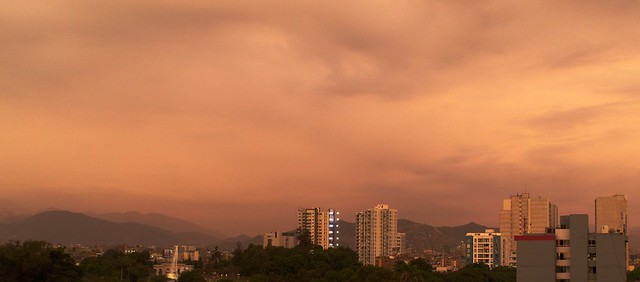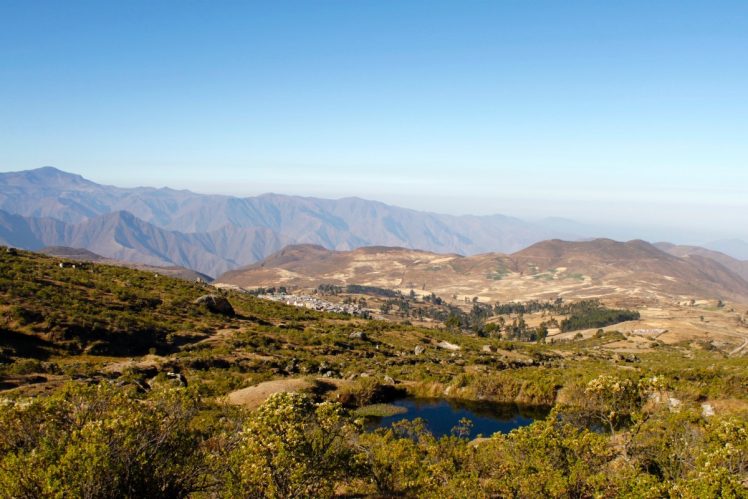
Lima’s water problem
Lima covers nearly 3000 km2 and represents a third of Peru’s total population. The city is receiving on average less than 10 mm of rain per year, and is a coastal desert city relying on seasonal Andean flows from the wetter Andean highlands of central Peru. With the backdrop of population growth, increasing climate variability and land use change in the Andes, there are concerns over Lima’s continued reliance on Andean water sources.
Historically, Lima’s water authority response to these threats has been to invest in large-scale ‘grey’ infrastructure, such as dams and reservoirs. However, the national water regulator SUNASS has now turned towards nature-based or ‘green’ approaches to water supply management. As part of this change in policy direction, SEDAPAL, Lima’s state-owned water and sewage company, is now also legally required to carry out watershed conservation projects in the highlands in order to preserve critical water resources in the interest of Lima but also in the interests of Andean communities that rely on the same resources.
The importance of scale framing
In a recent study published in in the Journal of Environmental Policy and Planning titled “The development and intersection of highland- coastal scale frames: a case study of water governance in central Peru” we have used the concepts of framing and policy storylines to understand exactly how this shift in policy reform has unfolded during the reform period of 2004-2015. We set out to explore, who were the enabling actors and how did they promote a particular view of Lima’s solution to the water crisis when interacting with others? How did that view matured in policy? Who are likely to be the winners and losers associated with these policy reforms?
Three prominent policy storylines
We have found three prominent policy storylines each of which is linked to different framings on how to achieve water security in Lima. Crucially, we find that the shift in water policy involves different players, potential winners and losers, and yet it has been thus far largely regarded as a zero sum game.

In the first policy storyline, ‘water scarcity in Lima’ is presented as an exclusively urban problem from Lima’s perspective. Depicting the city’s water supply as vulnerable. In this sense, any quest for a ‘green’ solution largely centred on water availability for Lima and the urban water users but largely missing important connections with rural water users and Andean highland ecosystems and communities.
Another storyline was formed around the ‘Compensation for Ecosystem Services mechanisms in Peruvian watersheds’. This storyline emphasised the need to consider highland-lowland relations, but nevertheless mostly for the purposes of securing lowland (urban) water challenges. Highland agricultural communities are recognised as key custodians of ecosystem services in the lowlands but other important frame dimensions such as those related to water for community agriculture are not recognised.
The ‘restoring ancestral water systems for agricultural production in Huamantanga’ policy storyline presented highland water problems caused by intensive cattle grazing. This storyline described the recent restoration of a pre-Incan infiltration canal in a highland agricultural community that has strong ties with Lima (Huamantanga). Clear references are made to the Huamantanga community not only rediscovering cultural links with ancestral practices and infrastructure, but also improving local agricultural production and livelihoods. Any potential benefits to Lima’s water supply are not at all, or only secondarily, mentioned.
Elements of all three storylines converged within NGO publications and press releases around the time SUNASS changed policy direction. As discussed in our paper:
“While not viewed as a silver bullet, combined watershed and canal restoration is presented in these articles as a low risk strategy and win-win scenario for all parties, even though the exact distribution and size of the ‘wins’ is yet to be evaluated and discussed with stakeholders in both upstream rural communities and Lima.”

Accepting frame diversity within water governance
What we found in the Lima case is that these different policy storylines imply that water issues are framed from rather different perspectives and a range of different scales. However, often those involved in shaping these storylines, such as the water authorities, urban and rural water users, water NGOs and the media are often not aware of the types of framings and assumptions they bring into the conversation. Also not all these actors can influence policy in the same way. Some have a stronger voice than others.
As international policy shifts into new directions and we see a stronger emphasis on nature-based solutions, it is important not to lose sight of the frame diversity (the variety of views and interests) which exists within water governance. In the case of Lima, we found strong evidence for this type of frame diversity at a time when Peruvian water policy institutions are turning towards new solutions and perhaps even trying to reshape their own organisational identities. We also find missing connections between urban and rural water users and challenges in terms of how water policy can best align their different needs. Furthermore, the relationship between highland communities, urban (coastal) water supply actors and the influence of international organisations is not always straightforward even if green approaches are often presented as conclusive and uncontested amongst these various groups of actors.
It is also evident that unequal power relations between the different groups are not always considered and this entails risks because some ideas and frames may ultimately get accepted more easily in policy while others become left behind. In particular, highland Andean communities have been put at the centre of the turn towards green water infrastructures. However, we do not always find strong evidence that their framings and the realities that these represent are part of efforts to make water for Lima both greener and more secure.
Hence any policy reform needs to be connected with active dialogue that will ensure that all the actors that are actually involved in these processes are aware of how they are positioned in a complex puzzle of water governance. This is particularly important as water challenges become increasingly interconnected across scales and regions.
Researcher, Sustainability Research Institute, School of Earth and Environment, University of Leeds.
Timos Kaprouzoglou
Researcher, Division of History, Science, Technology and Environment, KTH.
Research coordinator of the WaterCentre@KTH.

